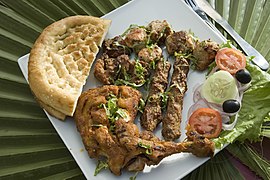Kheer
Kheer or Payasam is a type of pudding from the Indian subcontinent, made by boiling milk and sugar with one of the following: rice, broken wheat, millet, tapioca, vermicelli, or sweet corn. It is flavoured with desiccated coconut, cardamom, raisins, saffron, cashews, pistachios, almonds or other dry fruits and nuts. It is typically served during a meal or as a dessert.
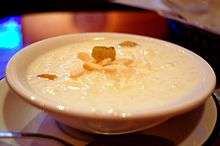 Kheer | |
| Alternative names | Payasam, Payasa and Ksheeram |
|---|---|
| Place of origin | Indian subcontinent |
| Region or state | India, Pakistan, Bangladesh, Sri Lanka, Bhutan, Nepal[1] |
| Main ingredients | Rice, milk, sugar, cardamom, jaggery, saffron, pistachios or almonds |
| Variations | Barley kheer, Kaddu ki kheer, paal (milk), payasam, payesh |
| 249 kcal[2] kcal | |
Etymology
The word 'Kheer' is derived from the Sanskrit word for milk, Ksheer(क्षीर). Ksheer is also the archaic name for sweet rice pudding.[3]
Origin
Kheer was a part of the ancient Indian diet and is mentioned in the Ayurveda.[4]
According to the food historian K. T. Achaya, kheer or payas, as it is known in southern India, was a popular dish in ancient India, first mentioned in ancient Indian literature, it was a mixture of rice, milk and sugar, a formula that has endured for over two thousand years. Payas was also a staple Hindu temple food, in particular, it was associated with Lord Shiva and served as Prasāda to his devotees.[5]
Regional variations
Payasam was always the main sweet dish at Hindu temples and part of their celebrations. It was mainly served in sadhya in marriage functions of Nair community. Other terms like Payasam or payesh (used in the Bengal region) are derived from the Sanskrit word Payasa or Payasam, which also means "milk". It is prepared using milk, rice, ghee, sugar/jaggery, and khoya but is less thick than original kheer. Some also add a little bit of heavy cream for a richer taste. It is often garnished using almonds, cashews, raisins and pistachios. There is one more popular version of North Indian kheer, prepared during festivals and havan in Varanasi by using only milk, rice, ghee, sugar, cardamom, dried fruit, and kesar (saffron milk). It is an essential dish in many Hindu feasts and celebrations. While the dish is most often made with rice, it can also be made with other ingredients, such as vermicelli (semiya in South India, seviyan, seviyaan, sayviah, or other spellings) or tapioca (locally known as sabudana). In Kashmir, firni is made with semolina (suji), milk, saffron, sugar, dry fruits, etc.[6]
In Gujarat, a variation of kheer known as dūdpāk, દૂધપાક, is also made. The ingredients remain largely the same, but the cooking process is different and wdudhpak is less dense and thick than kheer.
Rice was known to the Romans, and possibly introduced to Europe as a food crop, dating as early as the 8th or 10th Century AD,[7] and so the recipe for the popular English rice pudding is believed by some to be descended from kheer. Similar rice recipes (originally called potages) go back to some of the earliest written recipes in English history.[8]
- Pista matka kheer.
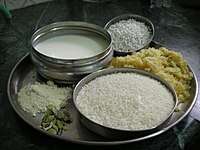 Ingredients for kheer.
Ingredients for kheer..jpg) Kheer Benazir, Karim's in Delhi, India.
Kheer Benazir, Karim's in Delhi, India.- Kheer made from semolina (suji).
East Indian version
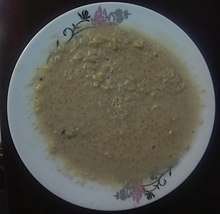
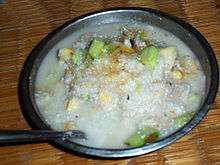
The Odia version of rice kheer (known as Kheeri) and (Payas in Northern Odisha) likely originated in the city of Puri, in Odisha more than 2,000 years ago.[9][10] Although original Kheer Payas originated as two separate dishes, they are increasingly considered by some to be similar but it is not. The Odia version has more fruits and is little less thicker. Payas are cooked to this day within the temple precincts there wheres as Kheer is available in restaurants mostly during Ramadan. Every single day, hundreds of temple cooks work around 752 hearths in what is supposed to be the world's largest kitchen to cook over 100 different dishes, including kheer, enough to feed at least 10,000 people.
Payas is also regarded as an auspicious food and generally associated with annaprashana (weaning ritual of an infant), as well as other festivals and birthday celebrations in an Odia household.
Although white sugar is commonly used, adding Gurh (jaggery) as a sweetener, is a variation prepared in Bengal and Odisha, especially during winter and spring when fresh gurh is available.
In Bengal, it is called payas or payesh. A traditional Bengali meal can be traced 2000 years old and it is one of important sweet dishes payas followed by other sweets.
Payesh is also regarded as an auspicious food and generally associated with annaprashana (weaning ritual of an infant) and Janmatithi (birthday) in a Bengali household. Payesh is made with rice (preferably gobindobhog rice), milk, and "guur" (jaggery/molasses) or sugar, often with raisins, cashew nuts, and cardamom as well. The people of West Bengal and Bangladesh prepare payesh variously with gurh, ketaki, glutinous rice (usually gobindobhog rice), vermicelli, semolina and coconut milk, and the result is a stickier and creamier dessert. Bengali kheer (which is different to payesh and is not to be confused with the Hindi word "kheer") does not have rice, and is made by prolonged boiling of milk with either sugar or gurh till the milk fat solidifies as thick flakes (heating it even longer would make rabri).
In Assam, it is called payoxh and in addition to other dried fruits, cherries are added to give it a light delicate pink colour. Sometimes rice may be replaced with sago. It is one of the most significant desserts served in Assamese families and quite often a part of religious ceremonies.
In Bihar, it is called "Chawal ki Kheer".[11] It is made with rice, full fat cream, milk, sugar, cardamom powder, an assortment of dried fruits, and saffron. Another version of this kheer, called Rasiya, is made with jaggery. Jaggery is used instead of sugar in the process. The jaggery version looks brown in color and has a mild, sweet taste.
South Indian version
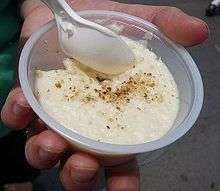
The South Indian version, payasam (Tamil: பாயசம், Malayalam: പായസം, Telugu: పాయసం, Kannada: ಪಾಯಸ), is an integral part of traditional South Indian meals. South Indian payasam also makes extensive use of jaggery (Tamil: வெல்லம் vellam, Telugu: బెల్లం bellam, Kannada: ಬೆಲ್ಲ bella, Malayalam: ശർക്കര sharkkara) and coconut milk in place of sugar and milk. Vermicelli (semiya) is commonly used. The most common types of payasam in South India include milk payasam,sago/tapioca pearl payasam, Semiya (vermicelli) payasam, Paruppu payasam, Nei (clarified butter) payasam (also known as Aravana payasam), Carrot payasam, Wheat payasam, Wheat rava (wheat semolina) payasam, and Arisi Thengai (coconut and rice) payasam, which is a traditional Iyengar-style recipe. It is not exactly Kheer, since most of the process is same it is generalised as Kheer. Payasam is less thicker and it contains semiya/vermicelli which is not a content of original Kheer.
In a South Indian meal, payasam or payasa, is served first at any formal or auspicious occasion. Payasam is also served after rasam rice, while rice with buttermilk forms the last item of the meal.[12] Payasam also forms an integral part of the Kerala feast (sadya), where it is served and relished from the flat banana leaf instead of cups. In Malayalee or Kerala cuisine, there are several different kinds of payasam that can be prepared from a wide variety of fruits and starch bases, an example being chakkapradhaman made from jackfruit pulp and adapradhaman made from flat ground rice.
The Hyderabadi version is called gil-e-firdaus. It is a thick kheer made with milk and bottle gourd. Gil-e-firdaus, literally translated, means "the clay of paradise".
Karnataka has different types of Payasa (ಪಾಯಸ),they maybe prepared with milk or coconut milk. 1. ಗಸಗಸೆ ಪಾಯಸ/gasa-gase payasa - payasa made with poppy seeds, coconut, jaggery, sometimes almonds are added too. This is also used to make ಅಪ್ಪೆ ಪಾಯಸ/ appey payasa ie poori with payasa. 2. ಅಕ್ಕಿ ಪಾಯಸ/akki payasa- made with rice, milk and jaggery 3. ಶಾವಿಗೆ ಪಾಯಸ/shavige payasa- vermicelli added to akki payasa or gasagase payasa 4. ಹೆಸರು ಪಾಯಸ/hesaru payasa- made with green gram pulses or moong dal, jaggery and coconut milk 5. ಗೋಧಿ ಹುಗ್ಗಿ/ godhi huggi - made with broken wheat, jaggery and coconut milk 6. ಎಳನೀರು ಪಾಯಸ/ ela-neeru payasa- coastal dish made of tender coconut
Other regional versions
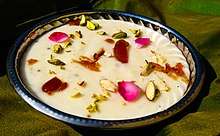
Across the Subcontinent, Payasam/Paisam is prepared and eaten at festivals. It is offered to Hindu deities as a bhog or prasadam. Since it is watery and contains vermicelli, it is tight to call it Payasam/Paisam but not Kheer.
Among the Muslims of the Indian subcontinent, the dish is mainly consumed during Ramadan and prepared for the feasts of Muslim weddings and festivals, such as Eid ul-Fitr and Eid ul-Adha.
A similar dessert, known as firni, is eaten in Iran, Azerbaijan, Afghanistan and among the Muslim communities of India, Bangladesh and Pakistan. Today, restaurants offer firni in a wide range of flavours, similar to kheer. Firni uses ground rice rather than whole rice.
See also
References
- "Bengali Payesh – Rice Kheer Recipe". Kfoods.com. Retrieved 28 June 2014.
- "Rice Kheer". Archived from the original on 10 May 2015. Retrieved 28 June 2014.
- https://food.manoramaonline.com/food/foodie/2019/07/12/sweet-story-payasam-indian-states.html
- "Kheer: The Quintessential Indian Milk Affair". Retrieved 21 April 2020.
- https://m.hindustantimes.com/india/a-truly-international-dessert/story-kfaP9BbuLcuyvCr5A03VGL.html
- "Kong Phirin —– A kashmiri dessert popularly known as Phirni".
- "WHKMLA : The History of Rice Cultivation in Europe". Zum.de. Retrieved 17 August 2018.
- Hieatt, Constance; Sharon Butler (1985). Curye on Inglysch. Early English Text Society. pp. 64, 68, 75. ISBN 0-19-722409-1.
- "Cooking With Kurma - Essays". Kurma.net. Retrieved 17 August 2018.
- "The many faces of Kheer: Think the famous rice pudding is an Indian invention? You will be surprised!". Indianexpress.com. 10 November 2014. Retrieved 17 August 2018.
- KhanaPakana.Com. "Chawal Ki Kheer recipes - KhanaPakana.com". Khanapakana.com. Retrieved 17 August 2018.
- "Sadya - the traditional vegetarian feast of Keralites". Kerala Tourism. Retrieved 17 August 2018.



